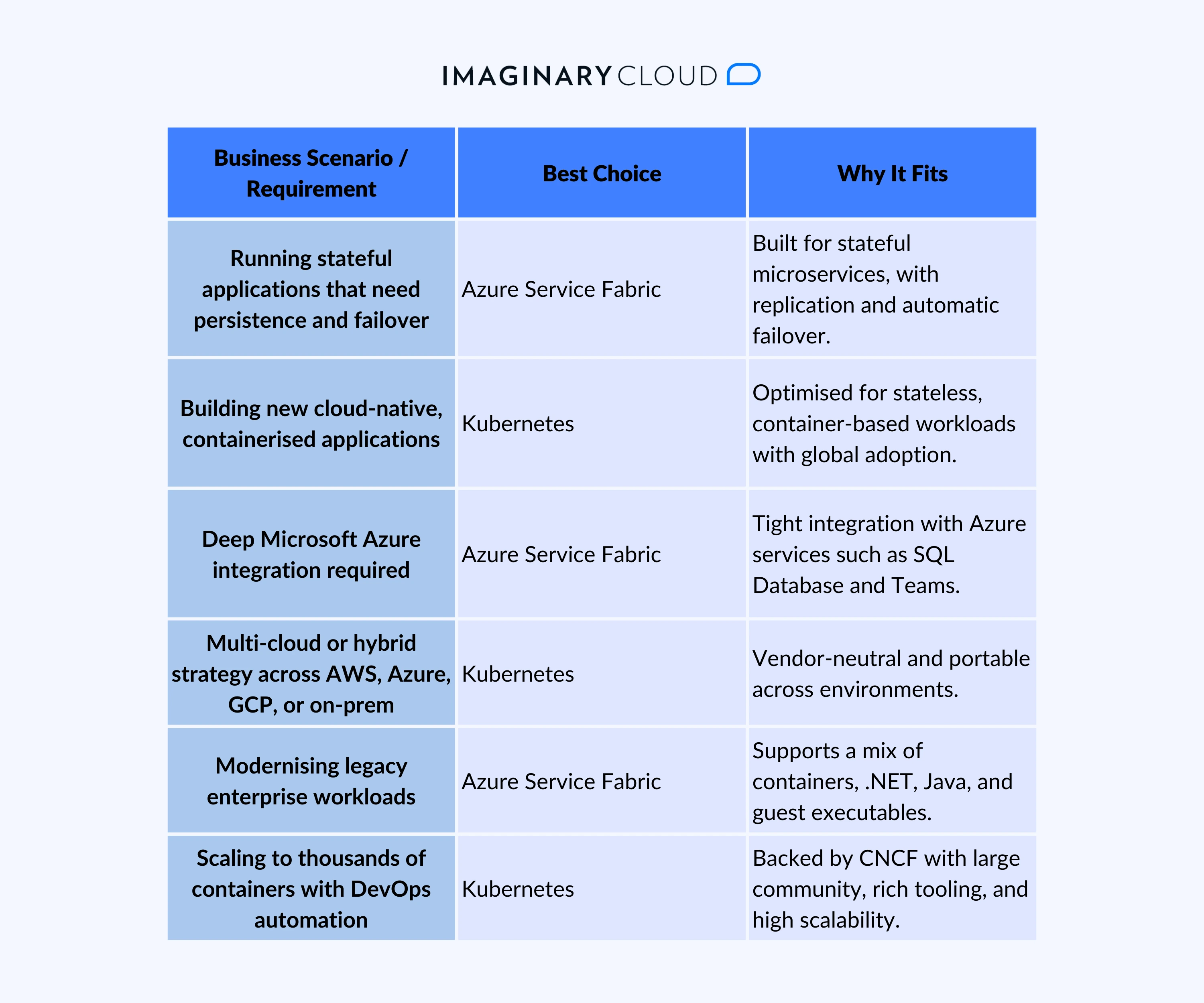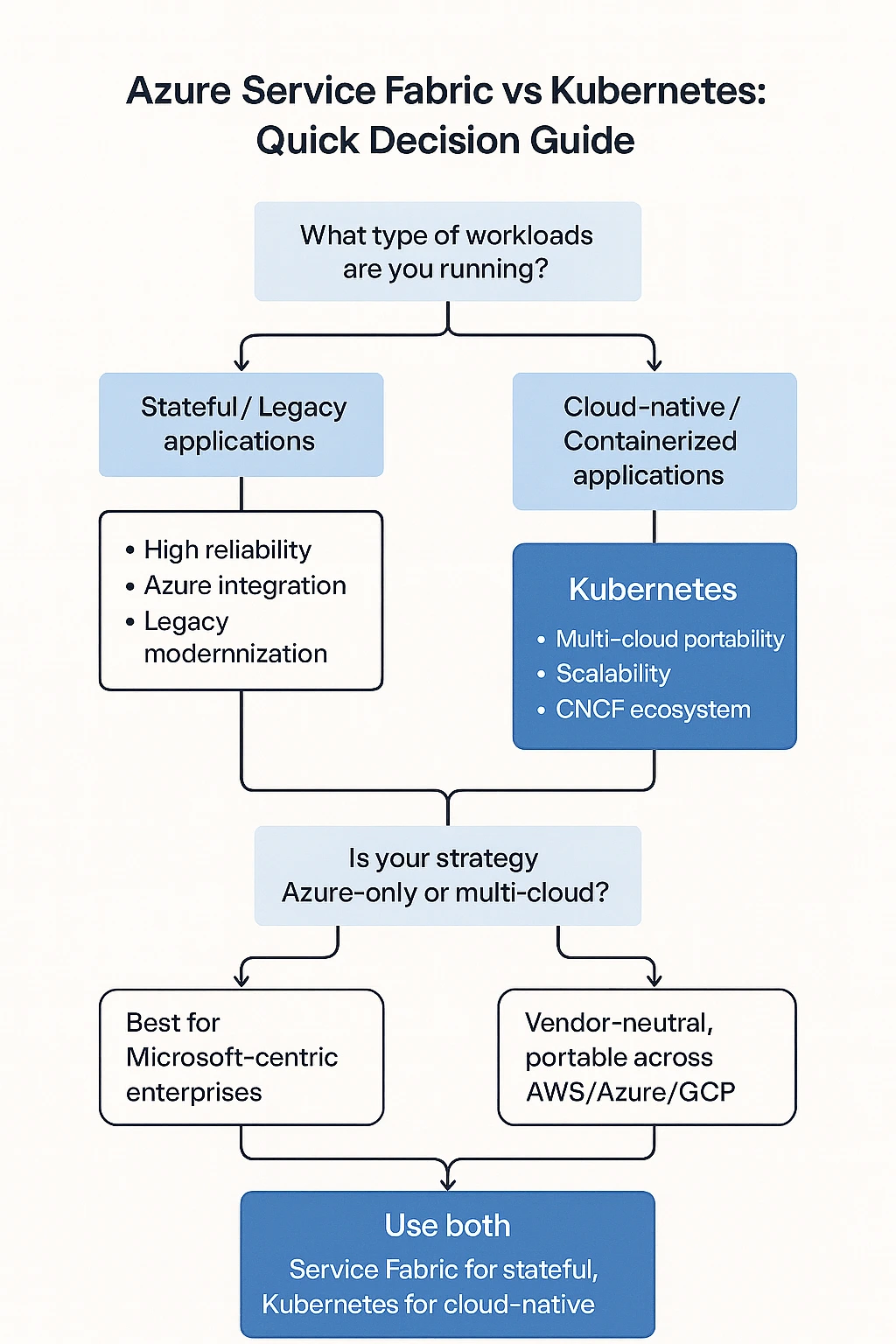contact us

.webp)
Azure Service Fabric and Kubernetes are both platforms for running and managing applications, but they differ in approach. Service Fabric is a Microsoft framework designed for microservices, including stateful workloads, while Kubernetes is a widely adopted container orchestration system focused on scalability and cloud-native, stateless applications.
Azure Service Fabric is a distributed systems platform from Microsoft that simplifies the deployment, management, and scaling of microservices. Unlike general container orchestrators, it was designed to support both stateful and stateless applications, making it well-suited to enterprise workloads that need reliability and high availability.
Key Features of Microsoft Azure Service Fabric:
How Azure Service Fabric Works:
Kubernetes is an open-source container orchestration platform originally developed by Google and now maintained by the Cloud Native Computing Foundation (CNCF). It automates the deployment, scaling, and management of containerised applications, making it the global standard for building cloud-native and stateless workloads.
Key Features of Kubernetes:
Why Kubernetes is Widely Adopted:
Azure Service Fabric and Kubernetes are often compared because both manage modern applications, but they are built for different needs. Service Fabric is designed for stateful enterprise workloads, while Kubernetes is the industry standard for container orchestration and cloud-native scalability.
Azure Service Fabric vs Kubernetes: Key Differences
.webp)
Summary of Key Differences:
The choice between Azure Service Fabric and Kubernetes depends on the type of applications you run, your cloud strategy, and the level of flexibility your organisation requires.
But hybrid adoption across the cloud ecosystem is now mainstream. A Statista survey shows that 82% of enterprises use hybrid architectures, combining on‑premises systems and public clouds to optimise workloads, making a mix of Service Fabric and Kubernetes a pragmatic choice for many organisations.
When to Choose Azure Service Fabric:
When to Choose Kubernetes:

“For most enterprises, the decision is not binary. A hybrid approach: Kubernetes for portability and agility, Service Fabric for Azure-bound reliability, is the pragmatic choice. What matters most is aligning cloud strategy with business outcomes, not technology trends.”
— Tiago Franco, Imaginary Cloud CEO
Key Takeaway:
Migrating between Azure Service Fabric and Kubernetes is possible, but it requires careful planning. The two platforms have different design philosophies, so a direct “lift and shift” is rarely successful. IT leaders should weigh technical, operational, and cost implications before committing to a migration.
Key Considerations for Migration:
Implementation Best Practices:
Key Takeaway
Migrating is a strategic shift that affects architecture, operations, and cost. Enterprises should evaluate both benefits and trade-offs, ideally with specialist support.

AI and machine learning workloads often require specialised infrastructure for data pipelines, model training, and inference. Both Service Fabric and Kubernetes can support these use cases, but they serve different niches.
AI/ML on Azure Service Fabric:
AI/ML on Kubernetes:

Key takeaway:
Both Azure Service Fabric and Kubernetes power critical enterprise workloads. The following examples show how large organisations apply each technology in practice.
1. Revenue Grid
2. Microsoft Teams (internal use)
3. Azure SQL Database (internal use)
1. Tinder
2. Capital One
3. The New York Times
Large-scale consumer platforms like Tinder and Reddit proved Kubernetes’ unmatched scalability, while Microsoft itself validated Service Fabric’s resilience in Teams and SQL Database. These examples show that technology selection is less about which platform is ‘better’, and more about aligning workloads with platform strengths.
Lessons Learned:
Azure Service Fabric and Kubernetes solve different problems:
Key takeaway: Many enterprises use both: Service Fabric for legacy systems, Kubernetes for new cloud-native projects.

Need guidance? Speak with our AI Experts to choose and implement the right platform for your business.
Is Service Fabric the same as Kubernetes?
No. Service Fabric is a distributed systems platform designed for microservices and stateful workloads, while Kubernetes is a container orchestration system focused on stateless, cloud-native applications.
What is the difference between Azure Service Fabric and AKS?
Azure Kubernetes Service (AKS) is a managed Kubernetes offering in Azure, designed for container orchestration. Azure Service Fabric is a separate platform that supports both containers and traditional microservices, with strong stateful capabilities.
Is Service Fabric still used?
Yes. Microsoft still runs core products such as Azure SQL Database and Microsoft Teams on Service Fabric, and enterprises use it for stateful, high-reliability workloads.
What is Azure Service Fabric used for?
Azure Service Fabric is used to deploy, manage, and scale microservices in enterprise environments. It is particularly valuable for stateful applications, large-scale Azure services, and hybrid deployments that require reliability and automatic failover.
Can Azure Service Fabric run containers?
Yes. Azure Service Fabric can host and orchestrate containerised workloads alongside traditional microservices. It supports both Windows and Linux containers, making it possible to mix containerised applications with .NET, Java, or guest executables in the same cluster.
.webp)

Alexandra Mendes is a Senior Growth Specialist at Imaginary Cloud with 3+ years of experience writing about software development, AI, and digital transformation. After completing a frontend development course, Alexandra picked up some hands-on coding skills and now works closely with technical teams. Passionate about how new technologies shape business and society, Alexandra enjoys turning complex topics into clear, helpful content for decision-makers.
People who read this post, also found these interesting: